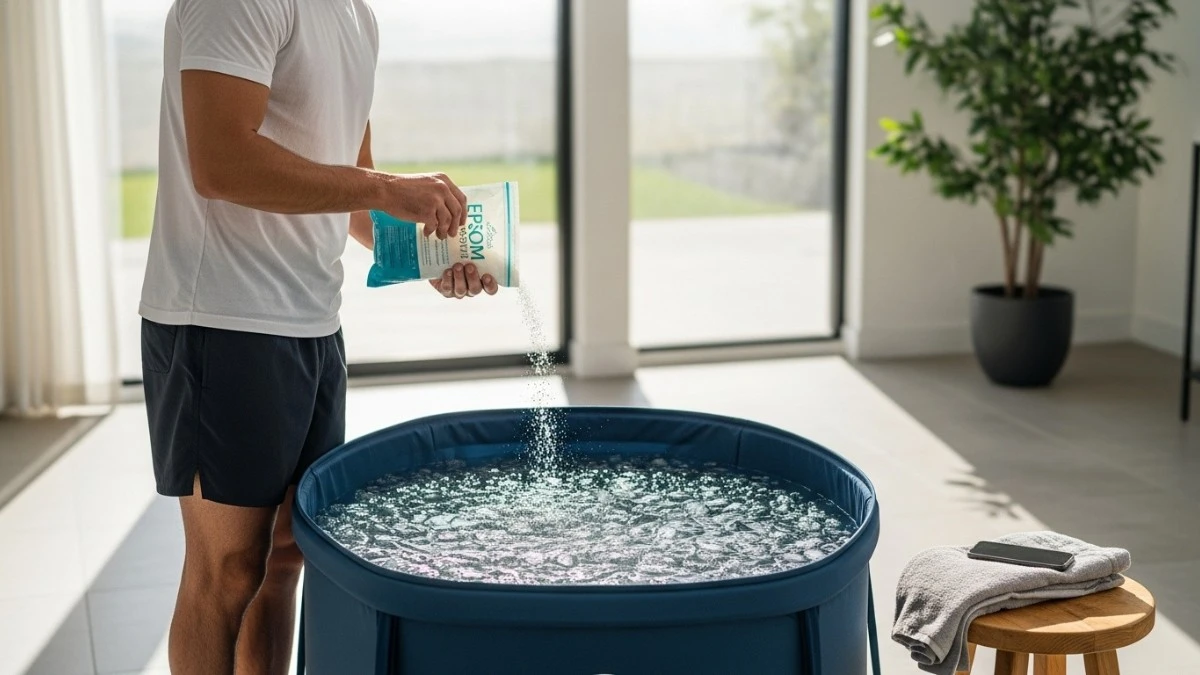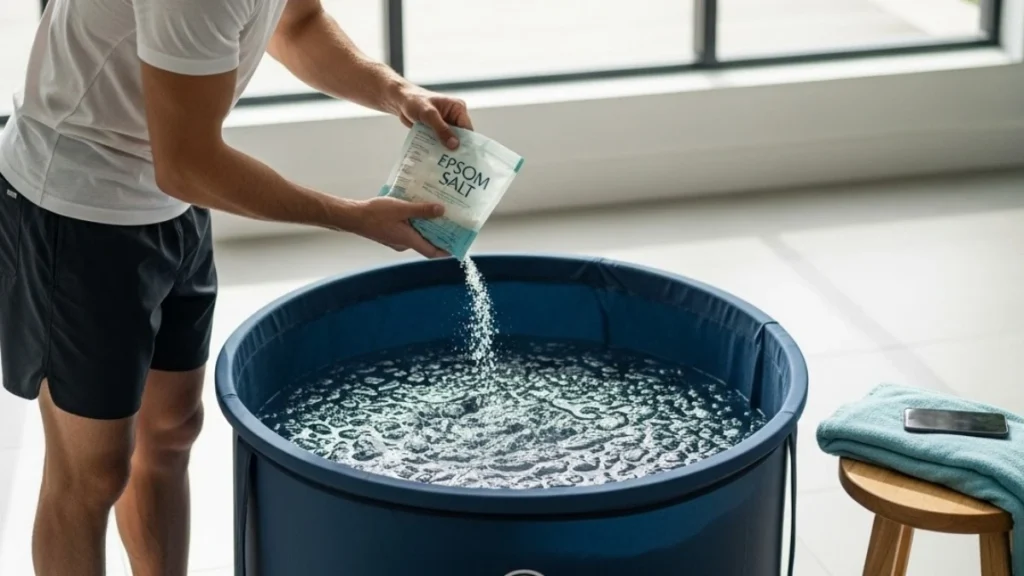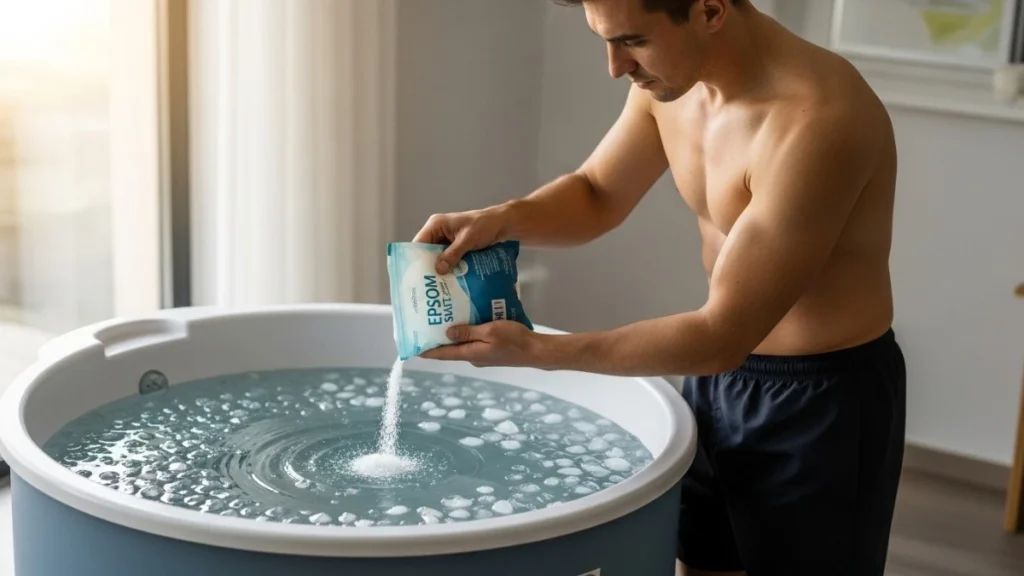Can You Put Epsom Salt In An Ice Bath? Expert Guide!

Last Updated on November 8, 2025
Muscle soreness after an intense workout can feel like a deep ache that lingers for days. When that happens, you might wonder which recovery ritual truly helps, ice baths, Epsom salts, or both together.
It’s a fair question, especially if you’re drawn to holistic recovery methods that support your body naturally.
So, can you put Epsom salt in an ice bath and double your recovery benefits? On the surface, it sounds like a smart move. combining magnesium-rich salts with cold therapy for ultimate relief. But in wellness and recovery, balance matters more than mixing trends.
In this guide, I’ll walk you through what science and experts actually say about combining Epsom salt and ice baths so you can make an informed, mindful choice that supports your body’s healing rhythm without unnecessary risks.
Quick Answer – Can You Put Epsom Salt In An Ice Bath?
When clarity matters, let’s go straight to the point.
Here’s why that matters: Epsom salt (magnesium sulfate) works best when your blood vessels are open and your pores relaxed, conditions created by warm water, not cold. In ice baths, blood vessels constrict, blocking absorption and reducing the salt’s potential effects.
It’s not dangerous in small amounts, but it’s also not especially effective. Instead, understanding how each therapy functions separately can help you design a more balanced recovery routine that truly benefits your muscles and mind.
Also Read: How Much Ice For Ice Bath?
The Rise Of Ice Baths And Epsom Salt In Recovery

Recovery used to mean rest and hydration. Today, it’s a ritual, from ice baths and Epsom salt soaks to contrast therapy and infrared saunas. These tools aren’t new, but they’ve gained new attention thanks to athletes, wellness enthusiasts, and everyday people seeking natural relief.
Epsom salt baths are often seen as warm, relaxing detox experiences that ease tension. Ice baths, on the other hand, are known for their invigorating chill that reduces inflammation and speeds up recovery.
Both have solid reputations but they serve very different physiological purposes.
That brings us back to the question: What really happens when you combine them? Before mixing salt into your cold plunge, let’s uncover the facts and the subtle science behind how each therapy interacts with your body.
Also Read: How To Keep Ice Bath Cold In Summer?
What Science Says About Epsom Salt And Cold Therapy
The science behind recovery rituals isn’t about trends, it’s about how your body responds.
Epsom salt baths have been used for centuries to relax muscles, reduce tension, and soothe the nervous system. The key compound, magnesium sulfate, is believed to support muscle function, regulate stress hormones, and promote calm.
These effects depend on warmth because heat helps blood vessels expand, improving magnesium absorption through the skin.
Cold therapy, in contrast, does the opposite. Ice baths trigger vasoconstriction, narrowing blood vessels to reduce inflammation and swelling. This is excellent for recovery after intense workouts but not ideal for mineral absorption.
One 2017 study published in The Journal of Physiology noted that cold exposure decreases blood flow to the skin, limiting nutrient uptake. That’s why mixing salt into an ice bath may not deliver the benefits you’re expecting, your body simply isn’t in the right state to use them effectively.
Pros And Cons Of Adding Epsom Salt To An Ice Bath

A mix of curiosity and wellness trends has led many people to experiment with combining these therapies. But does it truly help, or just sound good on social media?
Potential Perceived Benefits
There’s a reason people try it. Some users report smoother skin, a refreshed feeling, and a sense of lightness after mixing Epsom salt into cold water. That temporary sensation comes from the tightening effect of salt and cold, which can make your skin feel toned and invigorated.
For those who find ritual in recovery, the sensory experience of an icy, mineral bath might add a psychological boost, the feeling that you’re giving your body extra care. And in wellness, mindset matters. Still, most of these “benefits” are sensory or temporary rather than biological.
Also Read: Benefits Of Ice Baths For Weight Loss
Scientific Drawbacks and Risks
Now for the science-based truth: magnesium absorption simply doesn’t happen in cold water. The body’s natural reaction to cold, closing pores and tightening vessels, prevents that exchange.
Additionally, adding salt to cold water can make the bath slightly more drying or irritating, especially for those with sensitive skin, eczema, or small cuts.
It’s not inherently dangerous, but it’s unnecessary if recovery is your main goal. Warm water remains the proven method for absorbing Epsom salt effectively.
What Happens Chemically
There’s another small factor people often overlook, how salt changes the freezing point of water. Technically, salt can lower the freezing temperature, making the water slightly colder. However, this change is minimal in small amounts, and your body won’t notice the difference.
What you might feel is a subtle skin tightening or dryness after soaking, as salt naturally draws moisture from the surface of the skin through osmosis. This can make your skin feel firm but also mildly dehydrated, not the ideal outcome for recovery.
Better Alternatives To Epsom Salt Ice Baths
Let’s talk about what actually works as recovery should feel safe, effective, and restorative. There are better ways to experience the benefits of both Epsom salt and cold therapy without combining them.
Warm Epsom Salt Bath for Relaxation
A warm Epsom salt bath remains one of the simplest, most effective ways to unwind after a tough day. The heat opens your pores, allowing magnesium sulfate to be absorbed, while the salt itself helps draw out impurities.
I usually recommend adding 1–2 cups to a tub of comfortably warm (not hot) water and soaking for 15–20 minutes.
The warmth soothes tight muscles, calms your nervous system, and promotes deeper sleep. It’s not just physical relief, it’s a quiet, grounding ritual that helps your body and mind reset.
Classic Ice Bath for Inflammation
When you need to reduce soreness or swelling quickly, an ice bath is still the gold standard. It’s especially beneficial after intense strength or endurance workouts. The cold triggers vasoconstriction, which limits inflammation and speeds muscle recovery.
For safety, keep your ice bath temperature between 50°F–59°F (10°C–15°C) and limit your soak to 10–15 minutes. It’s a mindful way to challenge your body while helping it recover naturally, a practice rooted in both science and resilience.
Contrast Therapy (Hot and Cold Alternation)
Want the best of both worlds? Try contrast therapy, alternating between warm and cold baths. Begin with a warm Epsom salt soak to relax muscles, then move to a cold plunge for inflammation control.
This sequence promotes circulation, reduces soreness, and enhances muscle recovery. Studies on athletes have shown that contrast therapy improves blood flow and reduces muscle fatigue more effectively than cold exposure alone.
It’s one of my favorite tools for balancing comfort and recovery in the same session.
Add-Ons for a Safe Cold Bath Experience
If you enjoy customizing your cold baths, there are safe ways to enhance them. Add a few drops of lavender or eucalyptus essential oil for a calming aroma, or mix in baking soda to help soothe the skin.
Avoid harsh salts, synthetic oils, or bath bombs, which can irritate the skin during cold exposure. Keep your ritual simple, it’s about restoring the body, not overwhelming it with additives.
Also Read: How To Keep Ice Bath Water Clean?
How To Safely Use Epsom Salt In Ice Bath

Curiosity is part of every wellness journey. If you still want to experiment with adding Epsom salt to an ice bath, it can be done safely, as long as you approach it with awareness and moderation. Think of it less as a chemical formula and more as a personal trial to understand how your body responds.
Step-by-Step Preparation Guide
If you’re planning to try this combination, preparation makes all the difference.
Start by filling your tub halfway with cold water, then gradually add ice until the temperature feels bracing but tolerable, ideally around 50°F–59°F (10°C–15°C). Sprinkle in no more than half a cup of Epsom salt, stirring until it dissolves completely.
Lower yourself in slowly to allow your body to adjust. Take deep, steady breaths to calm your nervous system, the breath is your anchor here. Notice how your muscles feel during the first minute. Discomfort is normal, pain is not. Step out if anything feels sharp or overwhelming.
Duration and Frequency
In my practice, I often remind people that more is not better, especially with cold therapy. Keep the ice bath duration for 5 to 10 minutes on your first try. Even seasoned athletes rarely exceed 15 minutes.
Limit these sessions to two or three times per week at most. This gives your body enough time to rest and rebuild between exposures. What matters most is consistency and mindfulness, not intensity or duration.
Ask yourself afterward: Did my body feel calmer or more tense? Did my skin react well? Your answers will guide your next steps better than any trend or headline.
Safety Precautions
Not every recovery tool fits every body, and that’s perfectly okay. Avoid Epsom salt ice baths if you have open cuts, eczema, heart conditions, or diabetes. Salt and cold can both stress the skin and cardiovascular system when used excessively.
Hydration is another non-negotiable. Cold exposure can subtly dehydrate your tissues, especially if salt is present.
Drink water or an electrolyte-rich beverage afterward to restore balance. And when you step out of the bath, warm up gradually. Wrap yourself in a soft towel, move gently, and allow your circulation to return naturally.
Recovery should never leave you shivering or drained. It should feel cleansing, steady, and deeply grounding.
Mindful Recovery – Listening To Your Body
The most powerful wellness routines aren’t built from trends. They’re shaped by listening to your body’s signals, your energy, and your emotional state.
Whether you prefer warm Epsom salt baths or cold plunges, the real secret is self-awareness. After every session, pause and notice: Do your muscles feel lighter? Does your breathing slow? Does your mind quiet down? These subtle cues tell you more than any product label or protocol ever could.
If a cold plunge feels too harsh one day, choose warmth instead. If your energy feels low, focus on gentle movement like stretching or Pilates for recovery. The body’s needs shift daily, and honoring that rhythm is one of the deepest forms of self-care.
Recovery is not a competition, it’s a dialogue. And the more you listen, the more your body teaches you about balance and resilience.
Final Thoughts
Combining Epsom salt and ice might sound like a recovery shortcut, but in practice, their healing powers work best when used separately. Warm water helps Epsom salt deliver its magnesium-rich calm, while cold water offers inflammation control and muscle repair.
When used mindfully, each method complements the other, just not in the same bath. The key is tuning in to what your body truly needs that day. Some days call for warmth and stillness. Others ask for a brisk cold plunge to reset your energy.
Whichever path you choose, make it intentional. When recovery becomes a mindful ritual rather than a routine task, it stops being just about the body, and starts nourishing your whole sense of wellbeing.
Sources
- Ilkka Heinonen and Jari A. Laukkanen (2017). Effects of heat and cold on health, with special reference to Finnish sauna bathing
https://journals.physiology.org/doi/full/10.1152/ajpregu.00115.2017






